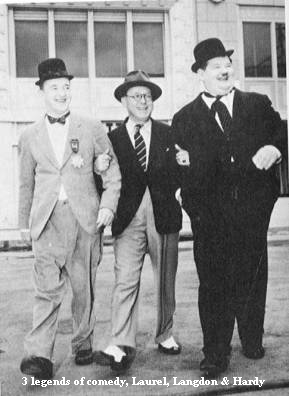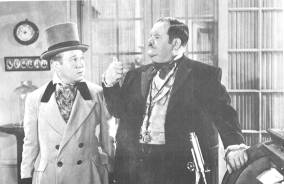|
and Hardy |
| The teaming of Laurel and Hardy was not only
inspired but also proved to be a long and loyal partnership. By 1928
their films had become well established and from then until their final
film, Atoll K in 1950, Stan and Ollie worked almost exclusively as a
team. In the case of Stan he never made a film after 1928 in which he
appeared without his American partner. Indeed, after Ollie’s death in
1957, Stan was offered several opportunities to make films with other
younger comedians, most notably being a lucrative offer to work as
script advisor to Jerry Lewis. Stan chose not to take up these offers
and in his heart and head the memory of the team Laurel and Hardy
remained. In Ollie’s case, although he was equally dedicated to the
partnership, circumstances arose which meant that after 1928, Ollie
appeared in 3 feature films without Stan. Each of these films starred
another big star of the screen. |
Langdon and Hardy
In 1939, Stan in trying to negotiate a better
deal with Hal Roach for the Laurel-Hardy partnership had found himself
out of contract with the studio. However Ollie was under a separate
contract and was teamed with one of the former greats of the silent
comedy era, Harry Langdon to make the talking feature Zenobia.
Langdon had been hailed as one of the 4 Great Silent Comedians (along
with Chaplin, Keaton and Lloyd) and was probably at his peak when he
made features at First National Studio such as The Strong Man
(1926) and Long Pants (1927). When the “talkies” arrived,
Langdon’s career declined. He secured work at the Hal Roach Studio and
made a series of short comedies but they failed to revive his career. It
seems likely that it was Stan Laurel’s influence and friendship that
helped find further work for Langdon at the Roach Studio. Langdon
contributed to scripts and with gags for the Laurel and Hardy films,
Block-Heads, Flying Deuces and Saps At Sea. An enduring connection
between Laurel and Hardy and Langdon remains in the film Flying Deuces
where a Parisian café artist is seen to be drawing a picture of Stan
and Ollie. The actual caricature, which is seen for a few brief seconds,
was in fact, the artistic work of Langdon. Stan never appeared on screen
with his old friend Langdon, but did not object to
Ollie appearing with Harry in Zenobia. |
 |
The
light comedy is set in a southern town in the 1870’s. Hardy is the
town’s physician but his medical skills are put to the test when he
has to treat a sickly elephant, Zenobia, owned by Langdon. Legal
complications arise and the final scene is one of a Court Hearing in
which the emotions of Hardy, Langdon and Zenobia are resolved. |
 |
| Speculation
abounded that the Laurel and Hardy team had ended when the film was
released. Thankfully this proved to be false and the Langdon and Hardy
film remains an enjoyable curiosity |

